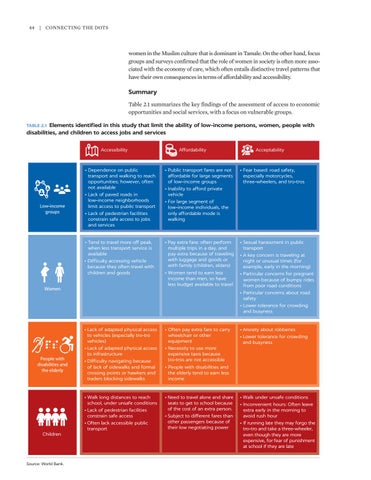44 | Connecting the Dots
women in the Muslim culture that is dominant in Tamale. On the other hand, focus groups and surveys confirmed that the role of women in society is often more associated with the economy of care, which often entails distinctive travel patterns that have their own consequences in terms of affordability and accessibility.
Summary Table 2.1 summarizes the key findings of the assessment of access to economic opportunities and social services, with a focus on vulnerable groups. TABLE 2.1 Elements identified in this study that limit the ability of low-income persons, women, people with disabilities, and children to access jobs and services
Accessibility
Low-income groups
Children
Source: World Bank.
Acceptability
• Dependence on public transport and walking to reach opportunities; however, often not available • Lack of paved roads in low-income neighborhoods limit access to public transport • Lack of pedestrian facilities constrain safe access to jobs and services
• Public transport fares are not affordable for large segments of low-income groups • Inability to afford private vehicle • For large segment of low-income individuals, the only affordable mode is walking
• Fear based: road safety, especially motorcycles, three-wheelers, and tro-tros
• Tend to travel more off peak, when less transport service is available • Difficulty accessing vehicle because they often travel with children and goods
• Pay extra fare: often perform multiple trips in a day, and pay extra because of traveling with luggage and goods or with family (children, elders) • Women tend to earn less income than men, so have less budget available to travel
• Sexual harassment in public transport • A key concern is traveling at night or unusual times (for example, early in the morning) • Particular concerns for pregnant women because of bumpy rides from poor road conditions • Particular concerns about road safety • Lower tolerance for crowding and busyness
• Lack of adapted physical access to vehicles (especially tro-tro vehicles) • Lack of adapted physical access to infrastructure • Difficulty navigating because of lack of sidewalks and formal crossing points or hawkers and traders blocking sidewalks
• Often pay extra fare to carry wheelchair or other equipment • Necessity to use more expensive taxis because tro-tros are not accessible • People with disabilities and the elderly tend to earn less income
• Anxiety about robberies • Lower tolerance for crowding and busyness
• Walk long distances to reach school, under unsafe conditions • Lack of pedestrian facilities constrain safe access • Often lack accessible public transport
• Need to travel alone and share seats to get to school because of the cost of an extra person. • Subject to different fares than other passengers because of their low negotiating power
• Walk under unsafe conditions • Inconvenient hours: Often leave extra early in the morning to avoid rush hour • If running late they may forgo the tro-tro and take a three-wheeler, even though they are more expensive, for fear of punishment at school if they are late
Women
People with disabilities and the elderly
Affordability



